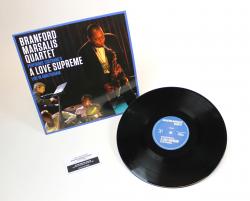 Coltrane’s A Love Supreme: Live in Amsterdam reissue from the Branford Marsalis Quartet out now and available on vinyl for the very first time Read more »
Coltrane’s A Love Supreme: Live in Amsterdam reissue from the Branford Marsalis Quartet out now and available on vinyl for the very first time Read more »
Miguel Zenón @ Sixth and I
Like this nation of immigrants whose disparate cultures converge to create something new, jazz also constantly evolves, in part by the infusion of hitherto unrelated styles of music. Latin jazz is a prime example of this musical melting pot, beginning with Dizzy Gillespie’s seminal collaborations with percussionist Chano Pozo and trumpeter Mario Bauza in the 1940s. But while this fusion tends to be with world music that has a more broad appeal, a recent trend has seen jazz musicians delving into the world’s folk traditions, in an attempt to blend the sophistication of modern jazz with a more organic sensibility.
Saxophonist Miguel Zenón has spent the past couple of years taking this approach, exploring plena, the street music of his native Puerto Rico. Zenón conducted extensive research into the 100-year history of this form, which led to the 2009 recording and release of his latest album, Esta Plena.
“[Plena] is derived directly from African music,” explained Zenón, during a recent interview with DCist. “It’s almost like our carnival music. It’s party music. It’s not complicated music. It’s not ritual music.”
Over the past 10 years, Zenón has established himself as one of the most important voices in Latin jazz. One of the first artists signed to Branford Marsalis’s Marsalis Music label, he is a founding member of the SFJazz Collective, winner of numerous critics’ polls, a 2003 Kennedy Center Jazz Ambassador, and a 2008 winner of the MacArthur Foundation’s celebrated “genius grant.” That preceded a Guggenheim grant supporting the research in Puerto Rico that led to Zenón’s latest release.
The Grammy nominee will be playing material from Esta Plena on Saturday at the Sixth and I Historic Synagogue for the latest installment of the Washington Performing Arts Society’s Sessions at Sixth and I concert series. Accompanying Zenón on Saturday will be bassist Ricky Rodriguez, drummer Henry Cole, and young piano whiz Alex Brown, who has blown us away in previous performances.
Plena is a very simple style of music, whose heartbeat comes from the panderos, a type of tambourine that plays a repeated rhythm. The melodies are layered over this, and there is also often a guitar, cuatro (a guitar-like instrument), or accordion in the ensemble adding basic harmonies. The music marks important events, and accompanies dancers and general festivities. While the album featured a septet, which included vocalists and some of the most respected plena artists, Saturday’s performance will be all instrumental, steering the music away from tradition and toward the contemporary.
“Even though we’re playing it from a jazz perspective, people still feel that folkloric color in the music,” said Zenón. “You have a main rhythmic core, but that doesn’t mean that you’ll play that one pattern over and over.”
While Zenón takes liberties with the music to fit it into a jazz format, he grew up hearing these sounds, so it is critical for him to maintain a strong respect for plena’s roots.
“That happens when you’re dealing with music that comes form the earth,” Zenón said. “That music connects with people. They hear something in there.”
Categories
Tags in Tags
Branford Marsalis Branford Marsalis Quartet ellis marsalis four mfs playin' tunes Joey Calderazzo Justin Faulkner Marsalis Family marsalis music metamorphosen miguel zenon music redeems new orleansFilter by Artist
Marsalis Music Radio
Join Our Mailing List
- RT @bmarsalis: Compliments of the @T_Blanchard archives. https://t.co/4RsXbyEloa — 1 year 26 weeks ago MarsalisMusic